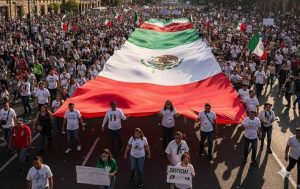 -Editorial
-Editorial
A march initially promoted on social media as a Generation Z–led protest against insecurity, corruption, and impunity gained momentum across Mexico on Saturday, with organizers calling for demonstrations in more than 50 cities. The online-driven movement spread rapidly through videos, hashtags, and short messages encouraging youth participation.
In Baja California, protesters gathered to demand stronger action against corruption and called for the resignation of Gov. Marina del Pilar Ávila Olmeda. The demonstration was marked by isolated acts of violence carried out by unidentified individuals wearing motorcycle helmets who damaged the door of the State Governor’s building. Authorities have not yet confirmed who was responsible.
Across the state, many residents have become increasingly critical of Gov. Marina del Pilar’s administration, citing concerns over her handling of public safety, rising crime rates, and ongoing insecurity.
The mobilization prompted a swift reaction from governors aligned with the ruling Morena party. In a joint statement, 23 governors and Mexico City’s head of government condemned the violence reported during the Mexico City protest, emphasizing that peaceful demonstration is fundamental to democratic life but that “no right can be exercised at the expense of public peace or the safety of the population.” The group also warned of the possible involvement of “political actors with interests unrelated to the common good” and reaffirmed their support for President Claudia Sheinbaum.
Morena issued its own statement rejecting what it described as an effort to portray the march as a spontaneous, youth-driven event. Party leaders claimed the protest was supported by conservative political figures and argued that turnout was modest in many cities. Morena also accused “radicalized” groups of provoking violence and criticized media coverage it said overstated the scale of the demonstrations.
Infodemia, a government-affiliated fact-checking agency, reported that billionaire Ricardo Salinas Pliego, former President Vicente Fox, and businessman Claudio X. González were among those promoting the march.
The demonstrations form part of a broader pattern of Gen Z–linked mobilizations observed globally over the past decade. Since the widely cited Gen Z–led protests in Bangladesh in 2024, similar youth-driven actions have emerged across Asia and other regions, fueled by concerns about inequality, corruption, democratic backsliding, and declining living standards. Social media continues to serve as a primary organizing tool for these movements.
Members of Generation Z, raised in the internet era, increasingly rely on digital platforms to coordinate political and social actions. Recent demonstrations in Morocco and Nepal were mobilized largely through platforms such as Discord, Instagram, TikTok, and Telegram. In Nepal, online activism intensified after the government imposed a social media ban in September 2025, which protesters denounced as censorship. In response, young activists turned to Facebook and TikTok to spread short videos alleging corruption and nepotism. Morocco’s “GenZ 212” Discord server expanded from 3,000 to more than 150,000 members by October 2, illustrating how quickly the movement resonated among young people.
Digital coordination also shaped the political actions that followed. In Nepal, protest organizers used Discord to conduct an online election for a temporary prime minister to lead a transitional government—an unprecedented example of Gen Z’s reliance on digital tools for civic engagement. Across multiple countries, the rapid expansion of these movements highlights the role of decentralized communication networks that allow young people to organize outside traditional political structures.
Pop culture symbolism has also become a defining feature of Gen Z–driven protests around the world. The Straw Hat Pirates’ Jolly Roger from the manga One Piece emerged as an emblem of solidarity, first appearing during demonstrations in Yogyakarta, Indonesia, in October 2023. The flag resurfaced in Indonesia’s 2025 anti-government protests and later in Nepal, where demonstrators hung it at the gates of the Singha Durbar palace during the ouster of Prime Minister K. P. Sharma Oli. The emblem has also appeared in protests in the Philippines, Peru, and Madagascar, drawing criticism from officials who argue the imagery is divisive or even treasonous. Other symbols, including references to Harry Potter and the three-finger salute from The Hunger Games, have been widely used across Southeast Asia. Observers say these references reflect a new era of youth mobilization shaped by digital, pop, and gaming culture.
As Saturday’s mobilizations continue to reverberate, analysts note that the protests—regardless of their political backing or competing narratives—underscore a growing generational divide and a mounting frustration with institutions seen as unresponsive to public concerns. Whether the emerging movement evolves into sustained civic pressure or dissipates amid political disputes remains to be seen, but its impact has already reignited national debate over security, accountability, and the power of digitally organized youth activism in shaping Mexico’s political landscape.


